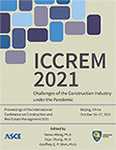Influence Factors on the Vitality of Old Communities in Guangzhou Using Multi-Source Data
Publication: ICCREM 2021
ABSTRACT
In recent years, urban development in China has gradually changed from incremental expansion to stock optimization, whereas urban renewal is becoming the mainstream implementation of urban development. As one part of the normalized work, renewal of old communities has always attracted much attention. To explore the vitality of old communities and its key influence factors, this study considers indexes from the following three perspectives of the old communities: basic characteristics, functions, and economic indicators. The community vitality evaluation model is constructed based on structural equation modeling. Multi-source data including POI (point of interest), population heat map, and review platform data are adopted to study the factors influencing the vitality of 215 old communities in Guangzhou. The results show that all three factors have a significant positive influence on the vitality of old communities. The community economy has the most significant influence on the vitality of communities, and the community functions and community economy have the second most significant influence.
Get full access to this article
View all available purchase options and get full access to this chapter.
REFERENCES
Dong, L., Fan, Y., Su, Y., and Feng, B. Y. (2015). “Preliminary study on the evaluation of vitality in existing residential communities.” Architectural Journal, 186–191. (in Chinese).
Gehl, J. (1987). Life between buildings: using public space, Van Nostrand Reinhold, New York.
Jacobs, J. (2016). The death and life of great American cities, John Wiley & Sons, Ltd, Chichester, London.
Jiang, L. (2013). Quantitative Assessment and Shaping Strategy of Vitality of Urban Streets. Dalian University of Technology, Liaoning, China, 1–80 (in Chinese).
Katz, P., Bressi, T. W., and Scully, V. J. (1994). The new urbanism: toward an architecture of community, McGraw-Hill, New York.
Long, Y., and Zhou, Y. (2016). “Quantitative evaluation on street vibrancy and its impact factors: a case study of Chengdu.” New Architecture, (01), 52–57. (in Chinese).
Niu, X. Y., Wu, G. S., and Li, M. (2019). “Influence of built environment on street vitality and its spatiotemporal characteristics based on LBS positioning data.” Urban Planning International, 34(01), 28–37. (in Chinese).
Tiesdell, S., Heath, T., and Oc, T. (1996). Revitalizing historic urban quarters, Architectural Press, Nottingham.
Wang, J. Q., Cao, Y. X., and Sun, Y. (2017). “Urban old community vitality enhancement creation practice.” Beijing Planning Review, 2017(02), 52–57. (in Chinese).
Zhang, C. Y., Zhang, G., and Zhou, H. Y. (2017). “The analysis and influence mechanism research of urban vigorous space based on multiple big data: a case study on the partial area of central Hangzhou.” Architecture & Culture, 2017(09), 183–187. (in Chinese).
Zhang, Y., Fang, Y., Niu, B., and An, Y. M. (2019). “Study on the vitality of urban living streets based on POI data: a case of Hongkou district in Shanghai.” Urbanism And Architecture, 16(31), 36–40. (in Chinese).
Zhou, B. R., and Zhang, Z. L. (2020). “A study on urban community vitality evaluation and its influencing factors based on big data analysis.” Journal of Suzhou University of Science and Technology (Engineering and Technology), 33(01), 57–62. (in Chinese).
Zhu, L., and Sun, L. (2007). “Urban regeneration in UK: concept, principles and the strategic approach to sustainable urban regeneration.” Urban Planning International, 2007(04), 1–5. (in Chinese).
Information & Authors
Information
Published In
Copyright
© 2021 American Society of Civil Engineers.
History
Published online: Dec 9, 2021
Authors
Metrics & Citations
Metrics
Citations
Download citation
If you have the appropriate software installed, you can download article citation data to the citation manager of your choice. Simply select your manager software from the list below and click Download.
